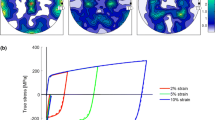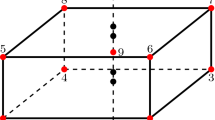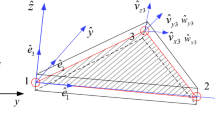Abstract
In this paper, two quadratic solid–shell (SHB) elements are proposed for the three-dimensional modeling of thin structures. These consist of a 20-node hexahedral solid–shell element, denoted SHB20, and its 15-node prismatic counterpart, denoted SHB15. The formulation of these elements is extended in this work to include geometric and material nonlinearities, for application to problems involving large displacements and rotations as well as plasticity. For this purpose, the SHB elements are coupled with large-strain anisotropic elasto-plastic constitutive equations for metallic materials. Although based on a purely three-dimensional approach, several modifications are introduced in the formulation of these elements to provide them with interesting shell features. In particular, a special direction is chosen to represent the thickness, along which a user-defined number of integration points are located. Furthermore, for efficiency requirements and for alleviating locking phenomena, an in-plane reduced-integration scheme is adopted. The resulting formulations are implemented into the finite element software ABAQUS/Standard and, to assess their performance, a variety of nonlinear benchmark problems are investigated. Attention is then focused on the simulation of various complex sheet metal forming processes, involving large strain, anisotropic plasticity, and double-sided contact. From all simulation results, it appears that the SHB elements represent an interesting alternative to traditional shell and solid elements, due to their versatility and capability of accurately modeling selective nonlinear benchmark problems as well as complex sheet metal forming processes.






































Similar content being viewed by others
References
Zienkiewicz OC, Taylor RL, Too JM (1971) Reduced integration technique in general analysis of plates and shells. Int J Numer Methods Eng 3:275–290
Cho C, Park HC, Lee SW (1998) Stability analysis using a geometrically nonlinear assumed strain solid shell element model. Finite Elem Anal Des 29:121–135
Hauptmann R, Schweizerhof K (1998) A systematic development of ‘solid-shell’ element formulations for linear and non-linear analyses employing only displacement degrees of freedom. Int J Numer Methods Eng 42:49–69
Puso MA (2000) A highly efficient enhanced assumed strain physically stabilized hexahedral element. Int J Numer Methods Eng 49:1029–1064
Sze KY, Yao LQ (2000) A hybrid stress ANS solid-shell element and its generalization for smart structure modelling, part I—-solid–shell element formulation. Int J Numer Methods Eng 48:545–564
Abed-Meraim F, Combescure A (2002) SHB8PS—a new adaptive, assumed-strain continuum mechanics shell element for impact analysis. Comput Struct 80:791–803
Kim JH, Kim YH (2002) A three-node \(\text{ C }^{0}\) ANS element for geometrically non-linear structural analysis. Comput Methods Appl Mech Eng 191:4035–4059
Alves de Sousa RJ, Cardoso RPR, Fontes Valente RA, Yoon JW, Grácio JJ, Natal Jorge RM (2005) A new one-point quadrature enhanced assumed strain (EAS) solid–shell element with multiple integration points along thickness: part I—geometrically linear applications. Int J Numer Methods Eng 62:952–977
Parente MPL, Fontes Valente RA, Natal Jorge RM, Cardoso RPR, Alves de Sousa RJ (2006) Sheet metal forming simulation using EAS solid–shell finite elements. Finite Elem Anal Des 42:1137–1149
Reese S (2007) A large deformation solid–shell concept based on reduced integration with hourglass stabilization. Int J Numer Methods Eng 69:1671–1716
Cardoso RPR, Yoon JW, Mahardika M, Choudhry S, Alves de Sousa RJ, Fontes Valente RA (2008) Enhanced assumed strain (EAS) and assumed natural strain (ANS) methods for one-point quadrature solid–shell elements. Int J Numer Methods Eng 75:156–187
Abed-Meraim F, Combescure A (2009) An improved assumed strain solid-shell element formulation with physical stabilization for geometric non-linear applications and elastic–plastic stability analysis. Int J Numer Methods Eng 80:1640–1686
Schwarze M, Reese S (2009) A reduced integration solid–shell finite element based on the EAS and the ANS concept—geometrically linear problems. Int J Numer Methods Eng 80:1322–1355
Li LM, Peng YH, Li DY (2011) A stabilized underintegrated enhanced assumed strain solid–shell element for geometrically nonlinear plate/shell analysis. Finite Elem Anal Des 47:511–518
Edem IB, Gosling PD (2012) One-point quadrature ANS solid–shell element based on a displacement variational formulation, part I–geometrically linear assessment. Comput Methods Appl Mech Eng 237–240:177–191
Flores FG (2013) Development of a non-linear triangular prism solid–shell element using ANS and EAS techniques. Comput Methods Appl Mech Eng 266:81–97
Pagani M, Reese S, Perego U (2014) Computationally efficient explicit nonlinear analyses using reduced integration-based solid–shell finite elements. Comput Methods Appl Mech Eng 268:141–159
Schwarze M, Vladimirov IN, Reese S (2011) Sheet metal forming and springback simulation by means of a new reduced integration solid–shell finite element technology. Comput Methods Appl Mech Eng 200:454–476
Salahouelhadj A, Abed-Meraim F, Chalal H, Balan T (2012) Application of the continuum shell finite element SHB8PS to sheet forming simulation using an extended large strain anisotropic elastic-plastic formulation. Arch Appl Mech 82:1269–1290
Trinh VD, Abed-Meraim F, Combescure A (2011) A new assumed strain solid–shell formulation “SHB6” for the six-node prismatic finite element. J Mech Sci Technol 25:2345–2364
Abed-Meraim F, Trinh VD, Combescure A (2013) New quadratic solid–shell elements and their evaluation on linear benchmark problems. Computing 95:373–394
Zienkiewicz OC, Taylor RL, Zhu JZ (2006) The finite element method, 6th edn. Elsevier, Amsterdam
Hallquist JO (1983) Theoretical manual for DYNA3D. Report UC1D-19041, Lawrence Livermore National Laboratory, Livermore
Simo JC, Hughes TJR (1986) On the variation foundations of assumed strain methods. J Appl Mech 53:51–54
Hill R (1948) A theory of the yielding and plastic flow of anisotropic metals. Proc R Soc Lond A 193:281–297
Timoshenko S, Woinowsky-Krieger S (1959) Theory of plates and shells, 2nd edn. McGraw-Hill, New York
Peng X, Crisfield M (1992) A consistent co-rotational formulation for shells using the constant stress/constant moment triangle. Int J Numer Methods Eng 35:1829–1847
Sansour C, Bufler H (1992) An exact finite rotation shell theory, its mixed variational formulation and its finite element implementation. Int J Numer Methods Eng 34:73–115
Sze KY, Liu XH, Lo SH (2004) Popular benchmark problems for geometric nonlinear analysis of shells. Finite Elem Anal Des 40:1551–1569
Park HC, Cho C, Lee SW (1995) An efficient assumed strain element model with 6 dof per node for geometrically nonlinear shells. Int J Numer Methods Eng 38:4101–4122
Sze KY, Chan WK, Pian THH (2002) An eight-node hybrid-stress solid–shell element for geometric non-linear analysis of elastic shells. Int J Numer Methods Eng 55:853–878
Hsiao KM (1987) Nonlinear analysis of general shell structures by flat triangular elements. Comput Struct 25:665–675
Barut A, Madenci E, Tesslerb A (1997) Nonlinear analysis of laminates through a Mindlin-type shear deformable shallow shell element. Comput Methods Appl Mech Eng 143:155–173
Smoleński WM (1999) Statically and kinematically exact nonlinear theory of rods and its numerical verification. Comput Methods Appl Mech Eng 178:89–113
Mostafa M, Sivaselvan MV, Felippa CA (2013) A solid-shell corotational element based on ANDES, ANS and EAS for geometrically nonlinear structural analysis. Int J Numer Methods Eng 95:145–180
Betsch P, Stein E (1999) Numerical implementation of multiplicative elasto-plasticity into assumed strain elements with application to shells at large strains. Comput Methods Appl Mech Eng 179:215–245
Fontes Valente RA, Alves de Sousa RJ, Natal Jorge RM (2004) An enhanced strain 3D element for large deformation elastoplastic thin-shell applications. Comput Mech 34:38–52
Cardoso RPR, Yoon JW (2005) One point quadrature shell element with through-thickness stretch. Comput Methods Appl Mech Eng 194:1161–1199
Wriggers P, Eberlein R, Reese S (1996) A comparison of three-dimensional continuum and shell elements for finite plasticity. Int J Solids Struct 33:3309–3326
Eberlein R, Wriggers P (1999) Finite element concepts for finite elastoplastic strains and isotropic stress response in shells: theoretical and computational analysis. Comput Methods Appl Mech Eng 171:243–279
Hauptmann R, Schweizerhof K, Doll S (2000) Extension of the ‘solid-shell’ concept for application to large elastic and large elastoplastic deformations. Int J Numer Methods Eng 49:1121–1141
Makinouchi A, Nakamachi E, Oñate E, Wagoner RH (1993) NUMISHEET’93, Proceedings of the 2nd international conference and workshop on numerical simulation of 3D sheet metal forming processes—verification of simulation with experiment, Isehara
Park DW, Oh SI (2004) A four-node shell element with enhanced bending performance for springback analysis. Comput Methods Appl Mech Eng 193:2105–2138
Zhang DJ, Cui ZS, Ruan XY, Li YQ (2007) An analytical model for predicting springback and side wall curl of sheet after U-bending. Comput Mater Sci 38:707–715
Dvorkin EN, Bathe KJ (1984) A continuum mechanics based four-node shell element for general nonlinear analysis. Eng Comput 1:77–88
Bouffioux C, Eyckens P, Henrard C, Aerens R, Van Bael A, Sol H, Duflou JR, Habraken AM (2008) Identification of material parameters to predict Single Point Incremental Forming forces. Int J Plasticity 1:1147–1150
Sena JIV, Alves de Sousa RJ, Valente RAF (2010) Single point incremental forming simulation with an enhanced assumed strain solid–shell finite element formulation. Int J Mater Form 3:963–966
Wriggers P (2006) Computational contact mechanics, 2nd edn. Springer, Berlin
Xu HJ, Liu YQ, Zhong W (2012) Three-dimensional finite element simulation of medium thick plate metal forming and springback. Finite Elem Anal Des 51:49–58
Yoon JW, Barlat F, Chung K, Pourboghrat F, Yang DY (2000) Earing predictions based on asymmetric nonquadratic yield function. Int J Plasticity 16:1075–1104
Yoon JW, Barlat F, Dick RE, Chung K, Kang TJ (2004) Plane stress yield function for aluminum alloy sheets, part II: FE formulation and its implementation. Int J Plasticity 20:495–522
Yoon JW, Barlat F, Dick RE, Karabin ME (2006) Prediction of six or eight ears in a drawn cup based on a new anisotropic yield function. Int J Plasticity 22:174–193
Schwarze M, Vladimirov IN, Reese S (2010) A new continuum shell finite element for sheet metal forming applications. Int J Mater Form 3:919–922
Barlat F, Lege DJ, Brem JC (1991) A six-component yield function for anisotropic materials. Int J Plasticity 7:693–712
Barlat F, Brem JC, Yoon JW, Chung K, Dick RE, Lege DJ, Pourboghrat F, Choi SH, Chu E (2003) Plane stress yield function for aluminum alloy sheets—part 1: theory. Int J Plasticity 19:1297–1319
Author information
Authors and Affiliations
Corresponding author
Rights and permissions
About this article
Cite this article
Wang, P., Chalal, H. & Abed-Meraim, F. Quadratic solid–shell elements for nonlinear structural analysis and sheet metal forming simulation. Comput Mech 59, 161–186 (2017). https://doi.org/10.1007/s00466-016-1341-8
Received:
Accepted:
Published:
Issue Date:
DOI: https://doi.org/10.1007/s00466-016-1341-8




